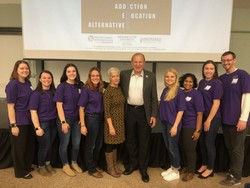Private college enrollment has decreased over recent years. According to the National Center for Education Statistics Projections, undergraduate enrollment at private colleges increased 38 percent over the past eight years, and is expected to increase by only 10 percent in the next eight years.
The center also says that a smaller portion of college students will be within the age range of 18-23.
Students under age 25 currently make up 60 percent of the college population. However, this can possibly decrease to 57 percent by 2021.
“Monmouth University is worth the expensive tuition because the school offers smaller classes compared to other schools. This gives students more of a “one on one” time with their professors while receiving a great education, said Dominique Mariano, a senior communication major.
Some public colleges within the state, such as Rutgers University, are known for their large class size. “I have friends who attend Rutgers University and when I ask them what they are learning in their classes, they never know what to say.” Mariano added.
Cara Ciavarella, a freshman communication major, said that she really appreciates Monmouth University’s small campus and all it has to offer.
“I love everything about the University, but this school is extremely expensive. People may be hesitant due to the high tuition,” said Ciavarella.
Robert McCaig, Vice President of the University’s enrollment department, said that there is a decrease in private school enrollment due to various factors. “Demographics, affordability, and the fact that the baby boom is over affects the [private] college enrollment rate,” said McCaig.
The demographics represent the high school students who aren’t college ready, or are choosing to attend community college first and the rate is declining in the Northeast area. Demographics play a vital role with this issue because it determines the number of potential freshman.
“Private universities and public schools aren’t making their enrollment quota. People have to realize that there’s a bigger picture. Using the financial aid package will help make private colleges more affordable,” said McCaig.
“After receiving financial aid, a student can possibly save money attending a private college compared to colleges that have a cheaper tuition,” said McCaig.
Society is also playing a vital role with the decrease of enrollment in private schools because society claims that college isn’t worth the enormous amount of college debt for young people.
Due to the high tuitions of college, especially private institutions, a lot of potential students are joining the military because that is an opportunity to have one’s education paid for.
As a result, military recruitment is on the rise while college recruitment is declining.
Schools with low enrollment are forced to respond with closures, layoffs, cutbacks, mergers, and new recruitment strategies. Many see these as the first signs of reorganization within the industry.
Private college enrollment has generally risen in economically stable periods and fallen when households’ incomes were hurt by financial hardships, according to the National Center for Education Statistics Projections.
A majority of these affected schools will have to learn to live with less.
Some schools have raised prices, hoping to receive more revenue from those who are rich and can afford it while offering more financial aid for others.
This strategy means the per-student net revenue is flat or decreasing at a lot of schools. Students and their families have become smart shoppers. As incentives grow, so do expectations.


